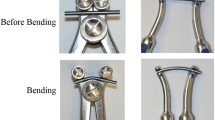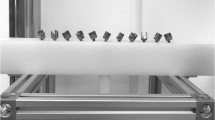Abstract
In a previous study, the authors examined the elastic and short-term anelastic springback of Ti6Al4V, CoCrMoC and A316L stainless steel spine rods to observe how the rods mechanically respond in OR contouring. In that study rods were 200 mm long and only the movement at the tip was recorded. The implication of that work was that rods will straighten in-vivo, however, in order for the mechanism of straightening to be determined, the movement of individual bends over time must first be elucidated. Spine rods used were, commercially pure titanium (CP Ti) a primarily α-phase; Ti-6Al-4V; α/β-phase titanium alloy from two different suppliers (denoted by, Ti-6Al-4V (L) and Ti-6Al-4V); β-phase titanium (TNTZ) and CoCrMoC. Following contouring the rods were aged unconstrained, in normal atmosphere or simulated body fluid (SBF) in a CO2 incubator for up to 288 h. Elastic springback is significantly different between alloys with different microstructures. Both types of Ti6Al4V rods, while meeting the ASTM F136 industry standard, have significantly different properties, most importantly yield strength, flexural modulus, and springback. Environment showed no significant impact on anelasticity. The anelastic response of Ti6Al4V L sample, which has relatively more beta phase than the Ti6Al4V sample, follows the pure beta phase TNTZ in its extended time response. CoCrMoC and CP Ti have a very reduced anelastic response compared to the other alloys. This potentially can have unanticipated effects on the outcome of spine procedures, as the surgeon is reliant on the rods having similar properties to achieve a desired outcome.





Similar content being viewed by others
References
Ayers RA, Burger EL, Kleck CJ, Patel VV. Metallurgy of Spinal Instrumentation. In: Mitsuo N, Takayuki N, Masaki N, editors. Advances in metallic biomaterials technology. springer series in biomaterials science and engineering. Heidelberg: Springer; 2015. p. 53–70.
Warren Y. Advances in spinal instrumentation. Oper Tech Orthop. 2003;13:159–70.
Hu SS, Pashman RS. Spinal instrumentation. Evolution and state of the art. Invest Radiol. 1992;27:632–47.
Noshchenko A, Xianfeng Y, Armour GA, Baldini T, Patel VV, Ayers RA, Burger EL. Evaluation of spinal instrumentation rod bending characteristics for in-situ contouring. J Biomed Mater Res. 2011;98B:192–200.
Barton C, Noshchenko A, Patel V, Kleck C, Burger E. Early experience and initial outcomes with patient-specific spine rods for adult spinal deformity. Orthopedics. 2016;39:79–86.
Burger EL, Baratta RV, King AGS, Easton R, Lu Y, Solomonow M, Riemer BL. The memory properties of cold worked titanium rods in scoliosis constructs. Spine. 2005;30:375–9.
Yoshihara H. Rods in spinal surgery: a review of the literature. Spine J. 2013;13:1350–8.
Broom MJ, Banta JV, Renshaw TS. Spinal fusion augmented by luque-rod segmental instrumentation for neuromuscular scoliosis. J Bone Joint Surg Am. 1989;71:32–44.
McLain RF, Sparling E, Benson DR. Early failure of short-segment pedicle instrumentation for thoracolumbar fractures. A preliminary report. J Bone Joint Surg Am. 1993;75:162–7.
del Rio J, Beguiristain J, Duart J. Metal levels in corrosion of spinal implants. Eur Spine J. 2007;16:1055–61.
Goldenberg Y, Tee JW, Salinas-La Rosa CM, Murphy M. Spinal metallosis: a systematic review. Eur Spine J. 2016;25:1467–73.
Akazawa T, Minami S, Takahashi K, Kotani T, Hanawa T, Moriya H. Corrosion of spinal implants retrieved from patients with scoliosis. Orthop Sci. 2005;10:200–5.
Niinomi M. Metallic biomaterials. J Artif Organs. 2008;11:105–10.
Zhou YL, Niinomi M. Microstructures and mechanical properties of Ti-50 mass% Ta alloy for biomedical applications. J Alloy Compd. 2008;466:535–42.
Silva EF, Oliveira LFC. Chemical and metallographic characterization of stainless steel in implants removed from patients. Acta Ortop Bras. 2011;19:280–5.
Gammon LM, Briggs RD, Packard JM, Batson KW, Boyer R, Domby CW. Metallography and Microstructures of Titanium and Its Alloys. G.F. Vander Voort, editor, ASM Handbook, Volume 9: Metallography and Microstructures. 2004. p. 899–917.
Adamus J, Lacki P. Forming of the titanium elements by bending. Comput Mater Sci. 2011;50:1305–1309.
Narita K, Niinomi M, Nakai M, Akahori T, Tsutsumi H, Oribe K. Bending fatigue and spring back properties of implant rods made of β-type titanium alloy for spinal fixture. Advanced Materials Research. 2010;89-9:400–404.
Nixon ME, Cazacu O, Lebensohn RA. Anisotropic response of high-purity α-titanium: Experimental characterization and constitutive modeling. International Journal of Plasticity. 2010;26:516–532.
Babu B, Lindgren LE. Dislocation density based model for plastic deformation and globularization of Ti-6Al-4V. International Journal of Plasticity. 2013;50:94–108.
Smith WF, Structure and Properties of Engineering Alloys 2nd Edition, McGraw-Hill, Inc., 1993.
Lim H, Lee MG, Sung JH, Wagoner RH. Time-dependent Springback. Int J Mater Form. 2008;Suppl 1:1577–160.
Xia ZC, Miller CE, Ren F. Springback Behavior of AA6111T4 with SplitRing Test AIP Conf. Proc. 2004;712:934–939.
Gan W, Babu SS, Kapustka N, Wagoner RH. Microstructural effects on the springback of advanced high-strength steel. Metallurgical and Materials Transactions A. 2006;37:3221–3231.
Gurao NP, Sethuraman S, Suwas S. Evolution of Texture and Microstructure in Commercially Pure Titanium with Change in Strain Path During Rolling. Metallurgical and Materials Transactions A. 2013;44:1497–1507.
Acknowledgements
This work was accomplished under NIH Grant 1R15AR060011-01.
Author information
Authors and Affiliations
Corresponding author
Ethics declarations
Conflict of interest
The authors declare that they have no competing interests.
Rights and permissions
About this article
Cite this article
Ayers, R., Hayne, M. & Burger, E. Spine rod straightening as a possible cause for revision. J Mater Sci: Mater Med 28, 123 (2017). https://doi.org/10.1007/s10856-017-5935-2
Received:
Accepted:
Published:
DOI: https://doi.org/10.1007/s10856-017-5935-2




